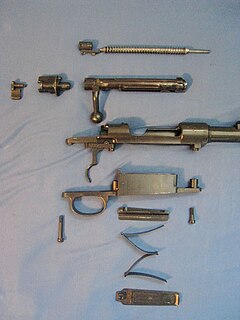
In firearms terminology, the firearm frame or receiver is the part of a firearm which integrates other components by providing housing for internal action components such as the hammer, bolt or breechblock, firing pin, extractor and trigger mechanism, and has threaded interfaces for attaching ("receiving") components such as the barrel, stock and action parts. The receiver is often made of forged, machined, or stamped steel or aluminium; in addition to these traditional materials, modern science and engineering have introduced polymers and sintered metal powders to receiver construction.

Selective laser sintering (SLS) is an additive manufacturing (AM) technique that uses a laser as the power source to sinter powdered material, aiming the laser automatically at points in space defined by a 3D model, binding the material together to create a solid structure. It is similar to Selective Laser Melting (SLM); the two are instantiations of the same concept but differ in technical details. Selective laser melting (SLM) uses a comparable concept, but in SLM the material is fully melted rather than sintered, allowing different properties. SLS is a relatively new technology that so far has mainly been used for rapid prototyping and for low-volume production of component parts. Production roles are expanding as the commercialization of AM technology improves.
The ArmaLite AR-18 is a gas-operated, selective-fire rifle chambered for 5.56×45mm NATO ammunition. The AR-18 was designed at ArmaLite in California by Arthur Miller, Eugene Stoner, George Sullivan, and Charles Dorchester in 1963 as an alternative to the ArmaLite AR-15 design, which had just been selected by the U.S. military as the M16. While the AR-18 was never adopted as the standard service rifle of any nation, its production licence was sold to companies in Japan and the United Kingdom, and it is said to have influenced many later weapons such as the British SA80, the Singaporean SAR-80 and SR-88, the American Adaptive Combat Rifle, the Belgian FN F2000, the Japanese Howa Type 89 and the German Heckler and Koch G36.

The 3D printing process builds a three-dimensional object from a computer-aided design (CAD) model, usually by successively adding material layer by layer, which is why it is also called additive manufacturing, unlike conventional machining, casting and forging processes, where material is removed from a stock item or poured into a mold and shaped by means of dies, presses and hammers.

3D Systems, headquartered in Rock Hill, South Carolina, is a company that engineers, manufactures and sells 3D printers. Chuck Hull, the CTO and former president, invented stereolithography in 1986. The company creates product concept models, precision and functional prototypes, master patterns for tooling, as well as production parts for direct digital manufacturing. It uses proprietary processes to fabricate physical objects using input from computer-aided design and manufacturing software, or 3D scanning and 3D sculpting devices.

Rapid prototyping is a group of techniques used to quickly fabricate a scale model of a physical part or assembly using three-dimensional computer aided design (CAD) data. Construction of the part or assembly is usually done using 3D printing or "additive layer manufacturing" technology.

Stratasys, Ltd. is an American manufacturer of 3D printers and 3D production systems for office-based rapid prototyping and direct digital manufacturing solutions. Engineers use Stratasys systems to model complex geometries in a wide range of thermoplastic materials, including: ABS, polyphenylsulfone (PPSF), polycarbonate (PC) and ULTEM 9085 and Nylon 12.

The Smith & Wesson M&P15 is an AR-15 style semi-automatic rifle by gun manufacturer Smith & Wesson. Introduced in 2006, the firearm is designed for police and consumer markets.

Defense Distributed is an online open-source hardware organization that develops digital schematics of firearms in CAD files, or "wiki weapons", that may be downloaded from the Internet and used in 3D printing or CNC milling applications. Among the organization's goals is to develop and freely publish firearms-related design schematics that can be downloaded and reproduced by anyone with a 3D printer or milling machine, facilitating the popular production of ghost guns.
Solid Concepts, Inc. is a custom manufacturing company engaged in engineering, manufacturing, production, and prototyping. The company is headquartered in Valencia, California, in the Los Angeles County area, with six other facilities located around the United States. Solid Concepts is an additive manufacturing service provider as well as a major manufacturer of business products, aerospace, unmanned systems, medical equipment and devices, foundry cast patterns, industrial equipment and design, and transportation parts.

The Liberator is a physible, 3D-printable single shot handgun, the first such printable firearm design made widely available online. The open source firm Defense Distributed designed the gun and released the plans on the Internet on May 6, 2013. The plans were downloaded over 100,000 times in the two days before the United States Department of State demanded that Defense Distributed retract the plans.
The AR Lower V5 is a 3D printed lower receiver for the AR-15 rifle. It was created in March 2013 Defense Distributed printed using the Stratasys Dimension SST 3-D printer using the fused deposition modeling (FDM) method.
The WarFairy P-15 is a 3D printed Fabrique Nationale P90 stock made public around May 2013. It was printed using a LulzBot Taz printer via the fused deposition modeling (FDM) method. It was created by WarFairy
The Hanuman AR-15 Bullpup which was made public in May 2014 is a prototype AR-15 rifle Bullpup created by WarFairy

Fused filament fabrication (FFF), also known under the trademarked term fused deposition modeling (FDM), sometimes also called filament freeform fabrication, is a 3D printing process that uses a continuous filament of a thermoplastic material. Filament is fed from a large coil through a moving, heated printer extruder head, and is deposited on the growing work. The print head is moved under computer control to define the printed shape. Usually the head moves in two dimensions to deposit one horizontal plane, or layer, at a time; the work or the print head is then moved vertically by a small amount to begin a new layer. The speed of the extruder head may also be controlled to stop and start deposition and form an interrupted plane without stringing or dribbling between sections. "Fused filament fabrication" was coined by the members of the RepRap project to give a phrase that would be legally unconstrained in its use, given trademarks covering "fused deposition modeling".
MyMiniFactory is an online community for designers and makers who want to share free or paid 3d printable designs. Unlike other sites, they guarantee the printability of their files. MyMiniFactory has over twelve categories of objects including Toys and Games, Props and Cosplay, Fan Art, Education, Jewellery, Gadgets, board games and tabletop, Home and Garden, Fashion and Accessories, Spare Parts, Sports and Outdoors, and Upcycling.
For a long time, the issue with 3D printing was that it has demanded very high entry costs, which does not allow profitable implementation to mass-manufacturers when compared to standard processes. However, recent market trends spotted have found that this is finally changing. As the market for 3D printing has shown some of the quickest growth within

A variety of processes, equipment, and materials are used in the production of a three-dimensional object via additive manufacturing. 3D printing is also known as additive manufacturing, therefore the numerous available 3D printing process tend to be additive in nature with a few key differences in the technologies and the materials used in this process.










